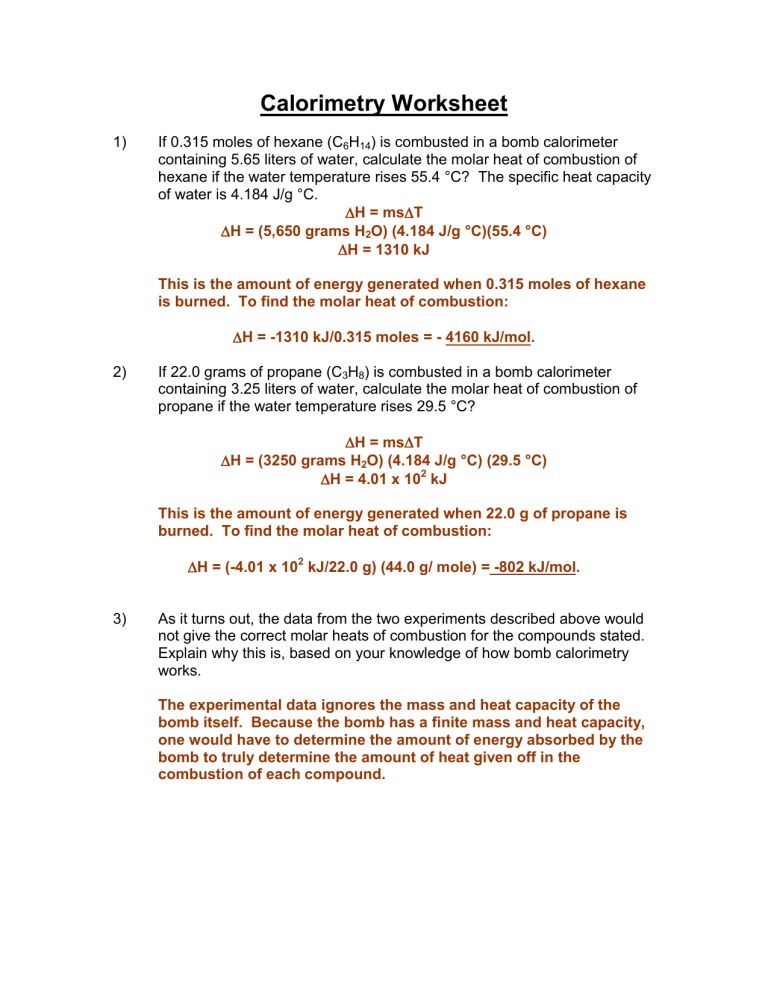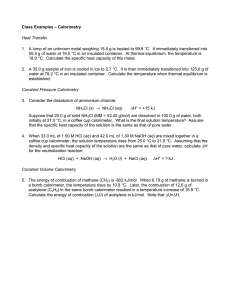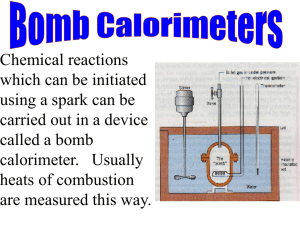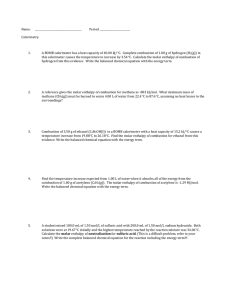
Calorimetry Worksheet 1) If 0.315 moles of hexane (C6H14) is combusted in a bomb calorimeter containing 5.65 liters of water, calculate the molar heat of combustion of hexane if the water temperature rises 55.4 °C? The specific heat capacity of water is 4.184 J/g °C. H = msT H = (5,650 grams H2O) (4.184 J/g °C)(55.4 °C) H = 1310 kJ This is the amount of energy generated when 0.315 moles of hexane is burned. To find the molar heat of combustion: H = -1310 kJ/0.315 moles = - 4160 kJ/mol. 2) If 22.0 grams of propane (C3H8) is combusted in a bomb calorimeter containing 3.25 liters of water, calculate the molar heat of combustion of propane if the water temperature rises 29.5 °C? H = msT H = (3250 grams H2O) (4.184 J/g °C) (29.5 °C) H = 4.01 x 102 kJ This is the amount of energy generated when 22.0 g of propane is burned. To find the molar heat of combustion: H = (-4.01 x 102 kJ/22.0 g) (44.0 g/ mole) = -802 kJ/mol. 3) As it turns out, the data from the two experiments described above would not give the correct molar heats of combustion for the compounds stated. Explain why this is, based on your knowledge of how bomb calorimetry works. The experimental data ignores the mass and heat capacity of the bomb itself. Because the bomb has a finite mass and heat capacity, one would have to determine the amount of energy absorbed by the bomb to truly determine the amount of heat given off in the combustion of each compound. 4) When 1.38 g of liquid PCl3 at 25.55 °C is added to 1.00 x 102 g of water at 25.55 °C in a ‘coffee-cup’ calorimeter, the temperature of the resulting solution increases to 32.00 °C. If the specific heat capacity of the solution is 4.184 J/°Cg, and the heat capacity of the Styrofoam cup is negligible, calculate the molar heat of solution of PCl3 in water. H = msT H = (101 grams soln.) (4.184 J/g °C) (6.45 °C) H = -2720 J This is the amount of energy generated when 1.38 g of phosphorus trichloride is dissolved. To find the molar heat of solution: H = (-2720 J/1.38 g PCl3)(137.33 g/ mole)(1kJ/1000J) = -271 kJ/mol. 5) A ‘coffee-cup’ calorimeter contains 150g of water at 24.6 °C. A 110 g block of molybdenum metal is heated to 100 °C and then placed in the water in the calorimeter. The contents of the calorimeter come to an average temperature of 28.0 °C. What is the specific heat capacity of the molybdenum metal if the specific heat capacity of water is assumed to be 4.184 J/°Cg? H = msT H = (150 grams H2O) (4.184 J/g °C) (28.0 - 24.6 °C) H = 2100 J This is the amount of energy released by 110 g of molybdenum. To find the heat capacity: s = H / m T s = (-2100 J)/(110 g Mb) (-72 °C) H = 0.27 J/g°C 6) When a 0.235 g sample of benzoic acid, C7H6O2, is combusted in a bomb calorimeter, a 3.62 °C rise in temperature occurs. When a 0.305 g sample of citric acid, C6H8O7, is burned, a 1.83 °C temperature rise is observed. If the heat of combustion of benzoic acid is 26.38 kJ/g, what is the molar heat of combustion of citric acid? First you need to calculate the heat capacity of the bomb calorimeter. Given that the temperature of the bomb calorimeter increases by 3.62 °C, the heat capacity of the calorimeter can be determined from the heat of combustion of benzoic acid. Hcombustion = -26.38 kJ/g q = (23.68 kJ/g)(0.235 g) = -6.20 kJ This is the amount of energy released when the benzoic acid was combusted. To find the heat capacity of the calorimeter: C = q /T C = (6.20 kJ) / (3.62 °C) C = 1.71 kJ/°C The heat evolved when 0.305 g of citric acid is combusted in the bomb calorimeter can be determined from the heat change and the heat capacity: q = C x T q = (1.71 kJ/°C)(1.83 °C) q = 3.13 kJ The molar mass of citric acid is 192.14 g/mol. The sample, 0.305 g, is equivalent to 1.59 x 10-3 mol. Hcombustion = q/moles Hcombustion = -3.13 kJ / 1.59 x 10-3 mol Hcombustion = -1970 kJ/mol



